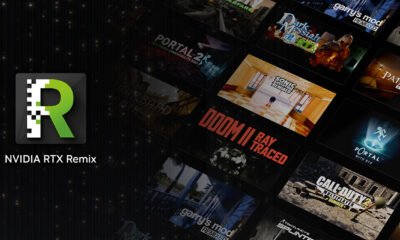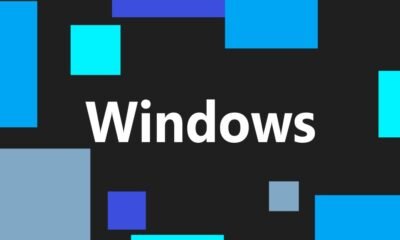I’ve long dreamed of doing all my gaming on PC — a single platform that’s easily upgradeable and lets me play my overstuffed Steam library wherever and however I like. The Steam Deck is a fantastic handheld, but for my living room, I want something more powerful that works as well on my TV as it does at a desk. Believe me, I’ve tried. Gaming laptops are noisy and awkward, desktops are too chunky, and Windows is annoying to navigate without a keyboard and mouse. I had hoped that Valve’s Steam Machine experiment was my ticket, but it crashed and burned long ago. Nothing’s ever been as easy as a PlayStation 5.
Top Stories
The Framework Desktop and Linux have shown me the path to PC gaming in the living room

But I’m newly optimistic. I’ve spent the past couple weeks using the Framework Desktop with a clever Linux distro called Bazzite: an open-source take on SteamOS. It’s a lot like installing the Steam Deck’s game mode and Proton compatibility layer for playing Windows games, and you can still optionally access a desktop for work too. It took me less than an hour to set up, and I’m now able to play PC games on my TV at 4K / 60fps — on a box that is smaller than a PS5, doesn’t get too noisy, and can be woken up from my couch with a gamepad.
This combo matches the simplicity of a docked Steam Deck, but it’s so much more powerful. And while a Framework Desktop isn’t as portable as a handheld — or even a laptop — it’s easy to move from room to room. I’ve even taken to working from it at my desk during the day, then moving it to the living room for after-hours game time. Sometimes you don’t want to play games in the same place you just worked for nine hours.
I so very badly want this to be the future of PC gaming.
The Framework Desktop is an ideal vessel for a Steam Machine-like experience. At 4.5 liters, it’s much smaller than most living room gaming computers, and much more powerful than your average home theater PC or streaming box. It’s way more expensive than a PS5 Pro — the Desktop starts at $1,099, or $1,999 for the AI Max+ 395 version I tested here with 16 CPU cores, 40 graphics cores, and 128GB of RAM — but it’s also much more than a gaming console.
I loved the Framework Desktop as a full Windows PC when I reviewed it earlier in August. And Bazzite is one of the easiest and most user-friendly desktop Linux incarnations. Bazzite makes it easier than ever to break away from Windows if you’re boycotting Microsoft, looking for an escape from Windows 10 before it’s cut off from updates in October, or just tired of Windows 11’s incessant pushing of services you don’t care about and attempts to extract recurring revenue from your wallet. The installer is easy, there’s a very capable OS if you switch over to desktop mode with a mouse and keyboard, and if you still need Windows for specific apps or games, you can always dual boot, like I did.
The only drawbacks I found were when I needed to run apps that aren’t compatible (like Adobe’s Creative Cloud suite) or the inevitable moments I had to open the Terminal to run simple commands. Many essential apps have native Linux support, like Chrome, Slack, Signal, Spotify, and Discord. And plenty of others can run with some compatibility help via Wine. But if much of your work and everyday computing needs are web-based, you’re good as gold on Linux.
Using Bazzite in desktop mode took me back to the days when I experimented with Ubuntu “Gutsy Gibbon” in college. (Didn’t we all give in to the temptation of the cube back then?) Linux is genuinely fun to use and tinker with. And Bazzite has a nice, somewhat no-frills aesthetic I admire.
1/4
Linux can and will drive the uninitiated down many rabbit holes, with lots of Googling how to do little things you take for granted on Windows and macOS, like understanding what the hell the KDE Wallet Service is (it’s for managing passwords) or remapping the Caps Lock key. I gave up on the latter and just remapped it at the hardware level on my keyboard with VIA.
But small frustrations aside, both the gaming side and desktop side of Bazzite are fantastic. While my job of reviewing laptops will always mean extensively using Windows, macOS, and some ChromeOS, it’s been kind of freeing to break away (even if just for a little bit) from the oppressive grips of the big three.
Now, if you’re interested in trying Bazzite and living a bit of that Linux life yourself, here’s how I set it up. It’s not totally foolproof, but it’s straightforward if you’re the tinkering type and can follow some simple guides (which I’ll link to).
Since I already had Windows 11 installed from my review of the Framework Desktop, I opted to install Bazzite on the second internal NVMe drive. You can dual boot from a single drive, with some precautionary measures, but it’s not uncommon to find forumgoers warning that Windows 11 can disrupt things like the boot order after running an update. Since sharing game files across Windows and Linux is also complicated, I decided to keep the OSes completely separate — which helped reinforce my work / play separation. I use the Bazzite drive for most of my gaming needs and boot into Windows when I need it for work (running Lightroom Classic for photo editing) or games that require it (PC Game Pass games, multiplayer titles with stricter anti-cheat measures, etc.).
I followed Bazzite’s official guide, cross-referenced Framework’s tutorial for the Laptop 16, and I was living the Linux life in less than an hour. Bazzite’s site has a user-friendly ISO picker for downloading the file you need to install the OS — typically by burning the ISO to a USB flash drive using a tool like Rufus. If you prefer video to written guides, Mike’s Tech Tips on YouTube is an invaluable resource, with a pleasant, calming voiceover to boot.
I only encountered one technical issue running Bazzite: There was no audio coming through the HDMI connection to my TV, despite my attempts to select “External Device” or “Default (External Device)” as my source. For some reason, this was fixed by entering desktop mode and switching the source there. It’s worked fine since.
It’s easy to alter the boot order of the Framework Desktop to prioritize the Bazzite drive. Booting up puts it right into Bazzite and its Steam Deck-like Big Picture Mode. And then, to access Windows without restarting and mashing an F-key to get to the boot menu, you can set up a script to reboot into Windows right from Bazzite’s Steam interface. You just go into the Bazzite desktop, open the Terminal, and type in the ujust code below. It does the work for you and adds a “boot-windows” option to the Steam Library.
Code: ujust setup-boot-windows-steam
As far as Linux has come, the Framework Desktop, or any other PC running Bazzite, probably isn’t the one gaming PC to rule my living room. Setting aside the requisite tinkering, there are still games it cannot play, either because they’re from services that aren’t supported (like PC Game Pass) or they reject Linux because they fear cheaters (like Fortnite or Valorant or the Battlefield 6 beta).
But color me impressed by Bazzite and even further by the Framework Desktop. I see why Bazzite has been gaining popularity with PC gamers. The time is ripe for Steam Machines to make a triumphant return, and I think this time it can work. Bazzite and devices like the Steam Deck and Framework Desktop are all showing the way.
Photography and screenshots by Antonio G. Di Benedetto / The Verge.
In my review, I found that the Framework Desktop is best equipped for 2.5K gaming, but the top-end Ryzen AI Max Plus 395 APU I’m using in this “Steam Machine” setup can do 4K at 60-ish frames per second on a TV. How smooth it runs and how good it looks depends on the game. Here’s a brief overview of some games I’ve been playing on it:
- Cyberpunk 2077: Playing Cyberpunk at 4K at around 60fps meant setting it to medium preset (no ray tracing, of course) with FSR set to balanced, and it looked and played great. Flipping on some “fake frames” with frame generation pushed it into the mid-80s. Not bad at all!
- Helldivers 2: It plays and looks great in 4K with medium settings and render scale set to balanced, hovering around the mid-60s. In busier areas it sinks to the 50s and briefly into the 40s when there are big explosions.
- Street Fighter 6: SF6 is meant to be locked at 1080/60, which is no problem. You can push it to 4K and still get a solid 60fps with most details and settings set to “normal” (medium).
- Monster Hunter Wilds: This is a bit of a torture test, due to Wilds’ infamously poor PC performance (though it’s been slowly improving). The game defaulted to FSR Ultra Performance mode and the lowest texture settings, which makes it look like a PlayStation 3 game. To keep things in 4K and actually looking decent I used FSR Performance and medium textures and turned on frame generation — this kept frame rates in the 70s or close to 80, which could bump to over 100 by dropping down to 2560 x 1440. Textures still aren’t great, but that’s just kind of how Wilds is unless you’re on top-tier hardware. It manages to play well overall and look solid.
- Elden Ring Nightreign: Just as on Windows, Nightreign plays at 4K / 50-ish on medium settings, or locked in at the 60fps max if bumped down to 2.5K. (Boy, what I’d give for a FromSoftware title with FSR / DLSS support.)
- Peak: A-okay at 4K on medium settings, with frame rates well into the 80s or higher.
Although some Windows games run better on Linux than on Windows, not all do. Black Myth: Wukong was about the same on either platform, but Cyberpunk 2077 actually ran 15fps slower in my benchmarks on Linux than in Windows with the same settings.
Top Stories
‘Rock of Love’ Star Kelsey Bateman Dead at 39

‘Rock of Love’
Kelsey Bateman Dead at 39 …
Starred on Season 3 of Reality Show
Published
Kelsey Bateman — a contestant on Bret Michaels‘ reality show ‘Rock of Love’ — has died … TMZ has learned.
A family sources tells us … Kelsey passed away unexpectedly recently — though it’s unclear at this time exactly what caused her untimely death. We’ve reached out to local authorities for more information.
If you don’t know “Rock of Love with Bret Michaels,” it was a reality television show that ran from 2007 to 2009 … and followed 25 contestants as they all vied to be Michaels’ girlfriend.
Kelsey starred in the third and final season of the show — titled “Rock of Love Bus with Bret Michaels” — on which the ladies lived on tour buses and traveled with Michaels.
Kelsey made it all the way to the final nine women … but was eliminated in dramatic fashion in the 7th episode.
Bateman showed up to the elimination drunk with several other contestants … telling the cameras she laid on a speed bump and broke down in tears because of the pressures of the show before showing up to the elim.
Bret said he felt Kelsey’s actions showed she simply wasn’t making smart decision for herself before sending her back to Salt Lake City, Utah.
Bateman was 39.
RIP
Top Stories
Notre Dame vs. Miami live updates: Carson Beck leads Hurricanes into battle with Irish in top-10 showdown

No. 6 Notre Dame and No. 10 Miami are set for a Sunday night showdown as college football’s Labor Day weekend marathon continue with a seismic clash between two iconic brands. It will mark just the fifth meeting since 1990 — and first since 2017 — between a pair of storied programs with lofty 2025 aspirations.
The Fighting Irish are coming off an appearance in the 2025 CFP National Championship and boast an elite running back tandem and loaded defense. Miami, now in Year 4 under coach Mario Cristobal, appears to have amassed the talent and physicality needed to break through after it was was left just outside of the 12-team CFP last season.
But now it’s time to show it on the field, and there are questions for both teams to answer, particularly at quarterback. Notre Dame is turning to redshirt freshman CJ Carr, the grandson of legendary former Michigan coach Lloyd Carr. Miami is going with Carson Beck, the Georgia transfer who is coming off surgery on his throwing elbow.
The winner will earn a leg up in the CFP race while the loser will see their margin for error shrink with a long season still ahead.
Keep it locked here as CBS Sports provides you with live updates, highlights and analysis as LSU battles Clemson to open the 2025 season in Week 1.
Top Stories
Judge blocks Trump administration move to deport Guatemalan children

A US judge has temporarily blocked an attempt by the Trump administration to deport dozens of unaccompanied Guatemalan children back to their home country.
District Court Judge Sparkle Sooknanan’s order on Sunday was in response to reports children had been put onto planes and were about to be sent to Guatemala, where lawyers argued they would be at risk of abuse and persecution.
The children arrived in the US alone and are in government custody while their immigration claims are assessed.
Lawyers for the US justice department said the children were not being deported, but rather repatriated so they could be reunited with family.
The legal proceedings were sparked early on Sunday when immigrant advocacy groups asked for an emergency injunction, claiming around 600 children could be put on planes in Texas and deported.
Judge Sooknanan then issued a temporary restraining order barring officials from sending a group of 10 migrant children between the ages of 10 and 17 to Guatemala.
At a hastily arranged hearing on Sunday afternoon, Judge Sooknanan, who was nominated by former President Joe Biden, expanded the order to cover all unaccompanied children said to be at risk of deportation. The order will be in place for 14 days.
At the hearing, Judge Sooknanan sought assurances from Trump administration lawyers that planes had not already departed with the children on board.
Deputy Assistant Attorney General Drew Ensign said all planes were “on the ground” in the US. He told the judge one plane may have taken off but had returned.
Ensign said the flights were not part of a deportation effort but for family reunifications with parents and other relatives in Guatemala.
He also said the Guatemalan government and the children’s relatives had requested the reunifications. Advocacy groups said that was untrue in at least some cases.
In court filings, lawyers for the children argued the action was in violation of federal laws designed to protect children who arrive in the US alone. They said some of the children had pending cases before immigration judges and expressed credible fears about being returned.
“In the dead of night on a holiday weekend, the Trump administration ripped vulnerable, frightened children from their beds and attempted to return them to danger in Guatemala,” Efrén C Olivares of the National Immigration Law Center, which filed the suit, said in a statement.
“We are heartened the court prevented this injustice from occurring before hundreds of children suffered irreparable harm.”
White House immigration advisor Stephen Miller criticised the judge for blocking the flights.
“The minors have all self-reported that their parents are back home in Guatemala,” he wrote on X. “But a Democrat judge is refusing to let them reunify with their parents.”
Since the start of his second term, Trump has embarked on sweeping efforts to remove undocumented migrants – a key election promise that drew mass support during this campaign.
In June, the US Supreme Court cleared the way for Trump to resume deportations of migrants to countries other than their homeland without giving them the chance to raise the risks they might face.
-
Tools & Platforms3 weeks ago
Building Trust in Military AI Starts with Opening the Black Box – War on the Rocks
-

 Business2 days ago
Business2 days agoThe Guardian view on Trump and the Fed: independence is no substitute for accountability | Editorial
-

 Ethics & Policy1 month ago
Ethics & Policy1 month agoSDAIA Supports Saudi Arabia’s Leadership in Shaping Global AI Ethics, Policy, and Research – وكالة الأنباء السعودية
-

 Events & Conferences3 months ago
Events & Conferences3 months agoJourney to 1000 models: Scaling Instagram’s recommendation system
-

 Jobs & Careers2 months ago
Jobs & Careers2 months agoMumbai-based Perplexity Alternative Has 60k+ Users Without Funding
-

 Education2 months ago
Education2 months agoVEX Robotics launches AI-powered classroom robotics system
-

 Funding & Business2 months ago
Funding & Business2 months agoKayak and Expedia race to build AI travel agents that turn social posts into itineraries
-

 Podcasts & Talks2 months ago
Podcasts & Talks2 months agoHappy 4th of July! 🎆 Made with Veo 3 in Gemini
-

 Podcasts & Talks2 months ago
Podcasts & Talks2 months agoOpenAI 🤝 @teamganassi
-

 Mergers & Acquisitions2 months ago
Mergers & Acquisitions2 months agoDonald Trump suggests US government review subsidies to Elon Musk’s companies
























